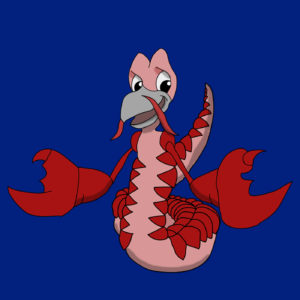Amikiri (ah-mee-kir-ree)
Amikiri were large marine crustaceans. They had long snake-like bodies with muscular tails and lived in crevices or burrows on the sea floor. Two arms ended in big claws. Highly prized as seafood, amikiri were economically important and were often one of the most profitable commodities in coastal areas they populated. Amikiri were invertebrates with a hard protective exoskeleton. They molted to grow, which left them vulnerable. Like snails and spiders, amikiri had blue blood due to the presence of copper in the bloodstream. In contrast, vertebrates and many other animals had red blood from iron-rich hemoglobin. Amikiri were found in all oceans. They lived on rocky, sandy, or muddy bottoms from the shoreline beyond the edge of the continental shelf. They lived singly in crevices or in burrows under rocks. Amikiri were omnivores and typically ate live prey such as fish, mollusks, other crustaceans, worms, and some plant life. They scavenged if necessary, and were known to resort to cannibalism in captivity. However, when amikiri skin was found in amikiri stomachs, this was not necessarily evidence of cannibalism – amikiris ate their shed skin after molting. These instances of amikiri cannibalism in the wild were theorized to be attributed to a local population explosion among amikiri caused by the disappearance of many of their natural predators.

